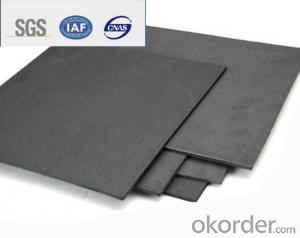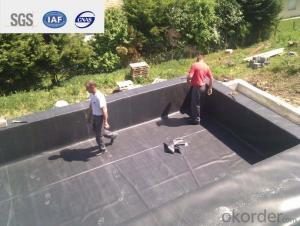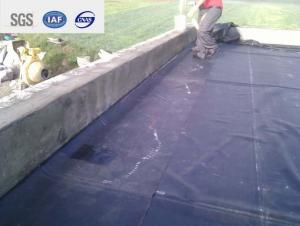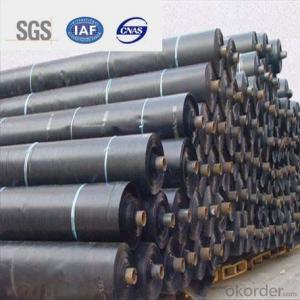EPDM Waterproofing Roofing Membrane for Roof 1.2mm
- Loading Port:
- Qingdao
- Payment Terms:
- TT OR LC
- Min Order Qty:
- 2000 m²
- Supply Capability:
- 800000 m²/month
OKorder Service Pledge
OKorder Financial Service
You Might Also Like
Description Of EPDM Rubber Waterproof Membrane:
1. EPDM waterproof membrane is made from ternary ethylene-propylene rubber, which is for waterproofing of exposed and non-exposed applications.
2. EPDM waterproof membrane production adopts the world-advanced equipment of cold feeding extrusion and continuous vulcanization technology.
3. EPDM waterproof membrane is of high elasticity among high polymer waterproof materials and becomes a world-popular waterproofing material.
Main Features of EPDM Rubber Waterproof Membrane:
1. Excellent physical and mechanical performance
2. High tearing resistance
3. Good deformation adaptability
4. High puncture resistance
5. High aging resistance
6. UV resistance
Specifications of EPDM Rubber Waterproof Membrane:
Material | EPDM Rubber |
Size | 1.2m (width)*20m (length) or customized, weldable type 2.05m or 4m width |
Thick | 1.2mm, 1.5mm, 2.0mm |
Type | Vulcanized & Weldable |
Pattern | Non-reinforced (homogeneous) |
Certificate | ISO9001/14001 |
Applications of EPDM Rubber Waterproof Membrane:
1.Roofs, Basement, Toilets
2. Industrial and civil building waterproofing
3. Geosynthetic liner for swimming pool, channels, irrigation system
4. Especially suitable for projects with high requirements in durability, anti-corrosion and deformation.
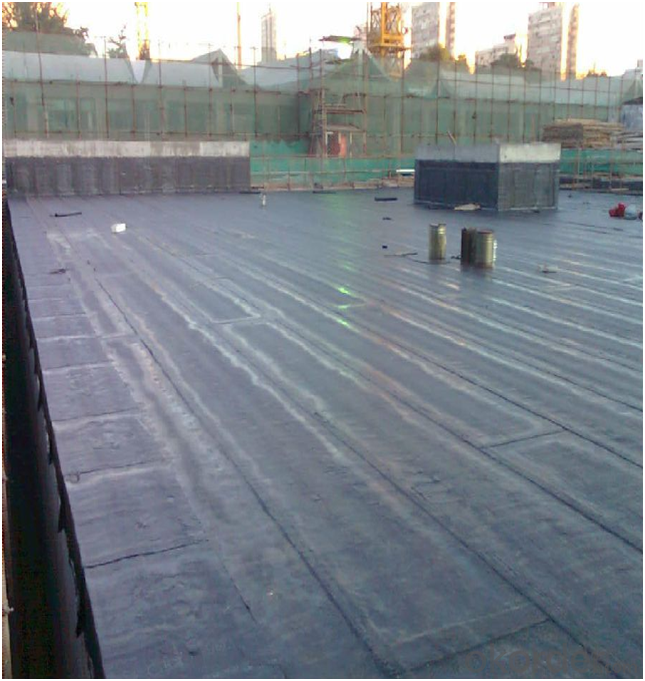


FAQ:
1. What are we supplying?
We are specialized in producing Colorful Asphalt Roof Shingle, SBS/APP modified bitumen waterproof membrane, Self adhesive bitumen waterproof membrane, PVC waterproofing membrane, EPDM rubber roofing membrane, Single Component Polyurethane Waterproof Coating, and Spray Polyurea Waterproof Coating.
2. How Many years experience do we have?
We have been exported to more than 20 countries in the past 15 years.
3. How long do we usually reply your request?
We always reply our customer within 24 hours.
- Q:Can a waterproofing membrane be used on sloped roofs?
- Indeed, sloped roofs can benefit from the application of a waterproofing membrane. Utilizing a waterproofing membrane on sloped roofs is frequently advised in order to thwart water infiltration and the potential for leaks. This membrane functions as a shield, safeguarding the roof structure against water penetration and subsequent harm. Furthermore, the membrane offers defense against additional elements like UV rays, temperature fluctuations, and mechanical strains. It is vital to select a waterproofing membrane designed explicitly for sloped roofs and compatible with the roofing material to guarantee enduring protection.
- Q:Can a waterproofing membrane be used for crawl spaces?
- Yes, a waterproofing membrane can be used for crawl spaces. Waterproofing membranes are commonly used in crawl spaces to prevent moisture and water infiltration, which can cause structural damage and promote mold growth. By installing a waterproofing membrane, it creates a barrier that keeps moisture out and helps maintain a dry and healthy crawl space environment.
- Q:Can waterproofing membranes be used on outdoor decks?
- Yes, waterproofing membranes can be used on outdoor decks. They provide an effective barrier against water and moisture, protecting the deck's structure and preventing damage from weather elements. Waterproofing membranes help to extend the lifespan of the deck and maintain its aesthetic appeal.
- Q:Can a waterproofing membrane be installed by a homeowner, or is professional installation necessary?
- A waterproofing membrane can be installed by a homeowner, but professional installation may be necessary depending on the complexity and scale of the project. Waterproofing membranes are used to prevent water penetration in areas such as basements, roofs, or shower enclosures. For small, straightforward projects like sealing a small basement crack, a homeowner with some DIY experience can typically install a waterproofing membrane themselves. There are various do-it-yourself products available in the market that come with easy-to-follow instructions. These products usually include self-adhesive membranes or liquid waterproofing coatings that can be applied with a brush or roller. However, when it comes to larger or more complex waterproofing projects, it is often recommended to seek professional installation. Professional waterproofing companies have the expertise, specialized tools, and experience to ensure a proper and long-lasting installation. They can assess the specific needs of your project, identify potential problem areas, and suggest the most appropriate waterproofing membrane system for your situation. Additionally, professional installation usually comes with warranties that provide peace of mind and protection against any future issues. In conclusion, while a homeowner can install a waterproofing membrane for small and simple projects, it is advisable to consult with professionals for larger or more complex installations to ensure the best results and long-term durability.
- Q:Can a waterproofing membrane enhance the durability or lifespan of a structure?
- Yes, a waterproofing membrane can definitely enhance the durability and lifespan of a structure. A waterproofing membrane is a protective layer that is applied to the exterior of a structure, such as a building or a bridge, to prevent water penetration. This membrane acts as a barrier, preventing the water from seeping into the structure and causing damage. Water is one of the most common and destructive elements that can impact the longevity of a structure. When water infiltrates a building or any other type of structure, it can lead to a multitude of issues such as mold growth, deterioration of building materials, corrosion of metal reinforcements, and even structural instability. By installing a waterproofing membrane, these risks can be significantly reduced or even eliminated altogether. The application of a waterproofing membrane not only helps to prevent water ingress but also protects the structure from other environmental factors like moisture, humidity, and freeze-thaw cycles. It acts as a shield against these elements, ensuring that the building materials remain intact and reducing the likelihood of cracks, leaks, and other forms of structural damage. By enhancing the durability of a structure, a waterproofing membrane can greatly extend its lifespan. The membrane serves as a long-term investment, as it helps to prevent costly repairs and maintenance caused by water-related issues. By keeping the structure dry and protected, it adds years or even decades to its lifespan, saving both time and money in the long run. In conclusion, a waterproofing membrane is an essential component in maintaining the durability and lifespan of a structure. By preventing water infiltration and protecting the building materials from damage, it ensures the longevity of the structure and provides peace of mind to its owners and occupants.
- Q:Can a waterproofing membrane be used for shipping containers or cargo holds?
- Indeed, shipping containers or cargo holds can benefit from the utilization of waterproofing membranes. These membranes are specifically engineered to act as a shield against moisture, effectively thwarting any potential water seepage. When applied to the internal or external surfaces of shipping containers or cargo holds, these waterproofing membranes prove instrumental in safeguarding the contents from any water-related harm during transportation. This becomes particularly crucial when dealing with valuable or delicate goods that are susceptible to moisture-induced deterioration. Moreover, the application of waterproofing membranes aids in preventing the formation of rust and corrosion on the metal surfaces of containers, thereby ensuring their endurance and longevity in the long run.
- Q:Can a waterproofing membrane be used on precast glass surfaces?
- Indeed, precast glass surfaces can benefit from the utilization of a waterproofing membrane. It is common for precast glass surfaces to possess joints and seams that allow water to infiltrate. Applying a waterproofing membrane can effectively establish a protective barrier against water penetration. By doing so, the waterproofing membrane acts as a safeguard, preventing moisture from seeping into the joints and causing potential harm to the precast glass. It is crucial to select a waterproofing membrane specifically designed for glass surfaces and to adhere to the manufacturer's guidelines for proper application. Moreover, it is prudent to perform regular maintenance and inspections to ensure that the waterproofing membrane remains effective over time.
- Q:Is a waterproofing membrane resistant to mold and mildew growth?
- Yes, a waterproofing membrane is typically resistant to mold and mildew growth. The membrane acts as a barrier against moisture, preventing it from seeping into the building materials and creating an environment for mold and mildew to thrive.
- Q:Can a waterproofing membrane be used for art installations or sculptures?
- Yes, a waterproofing membrane can be used for art installations or sculptures. Waterproofing membranes are commonly used in construction projects to prevent water infiltration and protect surfaces from moisture damage. In the context of art installations or sculptures, a waterproofing membrane can provide added durability and protection against environmental elements such as rain, snow, or humidity. This can be especially important for outdoor installations or sculptures that are exposed to the elements. Additionally, a waterproofing membrane can help preserve the integrity and longevity of the artwork, ensuring that it remains visually appealing and structurally sound over time. However, it is important to consult with professionals or experts in waterproofing to ensure the proper selection and application of the membrane, as different types may be more suitable for specific artistic materials or techniques.
- Q:Can a waterproofing membrane improve energy efficiency?
- Yes, a waterproofing membrane can improve energy efficiency. By preventing water infiltration and moisture buildup, it helps to maintain the integrity of the building envelope, reducing the risk of air leaks and heat loss. This can result in improved insulation performance, reduced energy consumption for heating or cooling, and ultimately contribute to overall energy efficiency.
1. Manufacturer Overview |
|
|---|---|
| Location | |
| Year Established | |
| Annual Output Value | |
| Main Markets | |
| Company Certifications | |
2. Manufacturer Certificates |
|
|---|---|
| a) Certification Name | |
| Range | |
| Reference | |
| Validity Period | |
3. Manufacturer Capability |
|
|---|---|
| a)Trade Capacity | |
| Nearest Port | |
| Export Percentage | |
| No.of Employees in Trade Department | |
| Language Spoken: | |
| b)Factory Information | |
| Factory Size: | |
| No. of Production Lines | |
| Contract Manufacturing | |
| Product Price Range | |
Send your message to us
EPDM Waterproofing Roofing Membrane for Roof 1.2mm
- Loading Port:
- Qingdao
- Payment Terms:
- TT OR LC
- Min Order Qty:
- 2000 m²
- Supply Capability:
- 800000 m²/month
OKorder Service Pledge
OKorder Financial Service
Similar products
New products
Hot products
Related keywords
